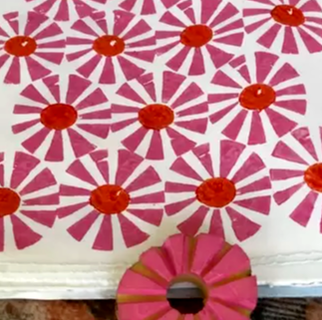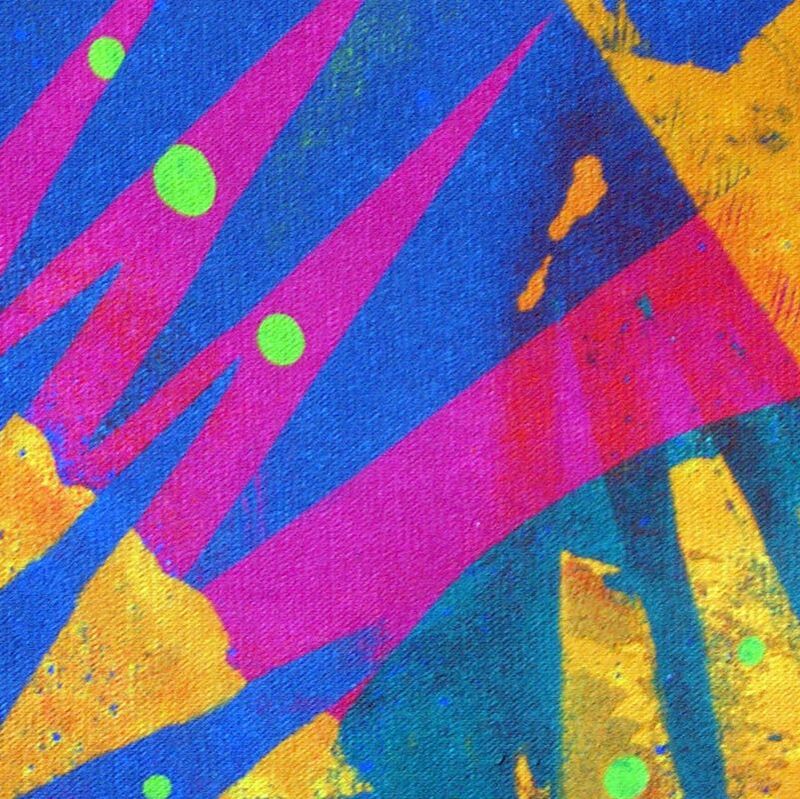About Printmaking
Seeing your print for the first time is like opening a gift on Christmas morning. You never really know what you're going to get- it's always a fun surprise! Printmaking is an amazing art form and students will LOVE playing with it.
Basics
What is Printmaking? It's the process of transferring an inked image from one surface onto another, most often onto paper or fabric. This transferred image is always the reverse or mirror image of the original.
What is a Monoprint? It's a printing technique where you can only create one print. This is the opposite of, for example, a rubber stamp, where you can reproduce an image over and over again. With a monoprint you can never reproduce the exact same image twice, hence the name monoprint.
A Few Printmaking Tools & Techniques
Brayer: A hand ink roller.
Manual Printing Press: Hand activated machine/gadget that presses down on a carved and inked block so that the image transfers evenly onto paper. Presses come in all sizes and can be very simple to very complicated and expensive.
Printing Inks: a type of ink that flows smoothly, dries quickly, and is of a consistency able to hold enough color to make the printed image legible. Comes in water-based or oil-based. Water-based is non-toxic.
Baren: a smooth disc shaped object, normally with a handle that you grip onto, which can be used for hand printing. It essentially provides a flat surface to distribute downward pressure across a small area. Once you’ve inked your printing block and laid a piece of paper over the top, you then rub the baren across the paper, forcing the ink to be applied to the paper.
Rainbow Roll: A fun way to get multiple colors onto a block print. Using a brayer, roll a few colors onto a sheet of plexiglass and then roll the block and then press that onto paper to get your colorful print.
Some Types of Printmaking
Stamping: The easiest form of printmaking- using an object with a flat side (often a small piece of rubber or wood or even a leaf). This is inked and then pressed onto, e.g. paper. The image can be repeated many times to create beautiful patterns.
Relief Printing: a family of printing methods where a printing block or plate which has had ink applied to its non-recessed surface, is brought into contact with paper or fabric. The non-recessed surface will leave ink on the paper, whereas the recessed areas will not- creating positive and negative images.
Block Print: Blocks of wood, linoleum or other materials are carved with images. These are then rolled with ink and then printed onto paper or fabric. FYI- a linoleum block print is also known as a linocut.
Woodcut: A relief technique using a plank of wood from which shapes are gouged away using chisels or knives, leaving the printing image as the raised surface. Ink is transferred from the surface of the block by the application of pressure. Woodcuts are characteristic both for the grain that is often evident in the printed image, as well as for their durability.
Linocut: A relief technique using a sheet of linoleum from which shapes are gouged away using chisels or knives, leaving the printing image as the raised surface. Ink is transferred from the surface of the block by the application of pressure. Linoleum is softer and therefore easier to carve than wood; however, it exhibits neither wood’s characteristic grain nor its durability.
Gelli Printing: a relatively new form of mono-printing that uses flexible gelatin-like printing plates to create textures and layers of acrylic paint color that are then printed onto paper.
Gelli-Block Printing: A fun technique that Pam came up with. Create a linocut (linoleum block), roll it with black ink and print it onto a Gelli Print.
Scratch Foam Prints: Marks are made on a sheet of flat styrofoam with pens or sharp objects like a toothpick. This is then rolled with ink and then printed onto paper. Scratch-foam prints are an easy form of Etching, which is done on metal or stone.
Clay Print: Created by Mitch Lyons, pigments and patterns are applied to a a slab of leather-hard clay. These images are then transferred onto a form of canvas. Pam studied with Mitch for many years and LOVES this technique.
What is Printmaking? It's the process of transferring an inked image from one surface onto another, most often onto paper or fabric. This transferred image is always the reverse or mirror image of the original.
What is a Monoprint? It's a printing technique where you can only create one print. This is the opposite of, for example, a rubber stamp, where you can reproduce an image over and over again. With a monoprint you can never reproduce the exact same image twice, hence the name monoprint.
A Few Printmaking Tools & Techniques
Brayer: A hand ink roller.
Manual Printing Press: Hand activated machine/gadget that presses down on a carved and inked block so that the image transfers evenly onto paper. Presses come in all sizes and can be very simple to very complicated and expensive.
Printing Inks: a type of ink that flows smoothly, dries quickly, and is of a consistency able to hold enough color to make the printed image legible. Comes in water-based or oil-based. Water-based is non-toxic.
Baren: a smooth disc shaped object, normally with a handle that you grip onto, which can be used for hand printing. It essentially provides a flat surface to distribute downward pressure across a small area. Once you’ve inked your printing block and laid a piece of paper over the top, you then rub the baren across the paper, forcing the ink to be applied to the paper.
Rainbow Roll: A fun way to get multiple colors onto a block print. Using a brayer, roll a few colors onto a sheet of plexiglass and then roll the block and then press that onto paper to get your colorful print.
Some Types of Printmaking
Stamping: The easiest form of printmaking- using an object with a flat side (often a small piece of rubber or wood or even a leaf). This is inked and then pressed onto, e.g. paper. The image can be repeated many times to create beautiful patterns.
Relief Printing: a family of printing methods where a printing block or plate which has had ink applied to its non-recessed surface, is brought into contact with paper or fabric. The non-recessed surface will leave ink on the paper, whereas the recessed areas will not- creating positive and negative images.
Block Print: Blocks of wood, linoleum or other materials are carved with images. These are then rolled with ink and then printed onto paper or fabric. FYI- a linoleum block print is also known as a linocut.
Woodcut: A relief technique using a plank of wood from which shapes are gouged away using chisels or knives, leaving the printing image as the raised surface. Ink is transferred from the surface of the block by the application of pressure. Woodcuts are characteristic both for the grain that is often evident in the printed image, as well as for their durability.
Linocut: A relief technique using a sheet of linoleum from which shapes are gouged away using chisels or knives, leaving the printing image as the raised surface. Ink is transferred from the surface of the block by the application of pressure. Linoleum is softer and therefore easier to carve than wood; however, it exhibits neither wood’s characteristic grain nor its durability.
Gelli Printing: a relatively new form of mono-printing that uses flexible gelatin-like printing plates to create textures and layers of acrylic paint color that are then printed onto paper.
Gelli-Block Printing: A fun technique that Pam came up with. Create a linocut (linoleum block), roll it with black ink and print it onto a Gelli Print.
Scratch Foam Prints: Marks are made on a sheet of flat styrofoam with pens or sharp objects like a toothpick. This is then rolled with ink and then printed onto paper. Scratch-foam prints are an easy form of Etching, which is done on metal or stone.
Clay Print: Created by Mitch Lyons, pigments and patterns are applied to a a slab of leather-hard clay. These images are then transferred onto a form of canvas. Pam studied with Mitch for many years and LOVES this technique.





